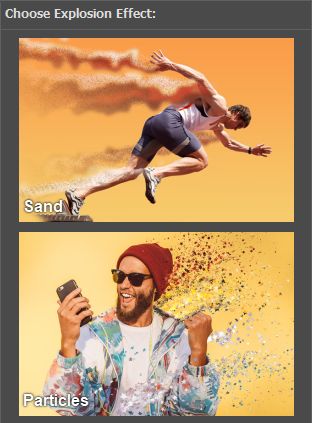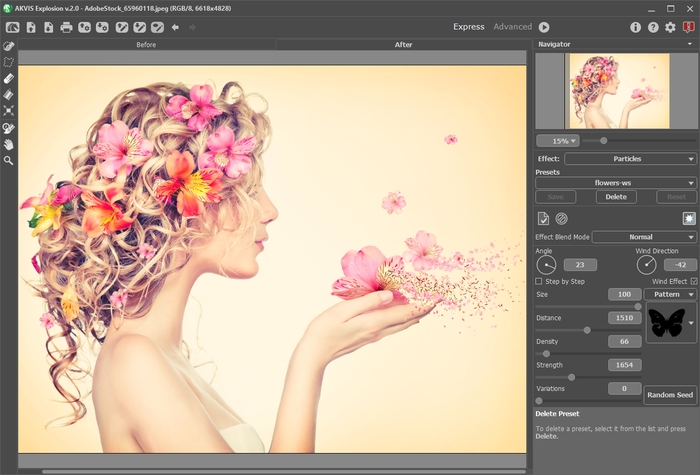Workspace
AKVIS Explosion can work independently as a standalone program or as a plug-in to a photo editor.
Standalone is an independent program. You can run it in the usual way.
Plugin is an add-on for graphics editors, for example for Photoshop, AliveColors, and other compatible programs. To call the plugin, select it from filters of your image editing program.
When you start the program, you will see the Explosion effects thumbnails. Click to choose the effect.

The workspace will be arranged according to the interface mode: Express or Advanced. In Express mode, the program's interface is extremely simplified and offers the minimal set of parameters and a full list of the ready-to-use presets.

AKVIS Explosion Workspace, Express Mode
In Advanced mode, the full functionality of the program is accessible, with all tools and parameters.

AKVIS Explosion Workspace, Advanced Mode
Elements of the program window:
Most of Explosion's window is taken up by the Image Window with two tabs, Before and After. The original image is displayed in the Before tab, and the After tab shows the result. You can switch between the windows by clicking on a tab with the left mouse button.
In the upper part of the program's window you can see the Control Panel with the following buttons:
- The button
 opens the home page of AKVIS Explosion.
opens the home page of AKVIS Explosion.
- The button
 (only in the standalone version) opens an image for processing. The hot-keys for the command are Ctrl+O on Windows, ⌘+O on Mac.
(only in the standalone version) opens an image for processing. The hot-keys for the command are Ctrl+O on Windows, ⌘+O on Mac.
- The button
 (only in the standalone version) saves image to the disk. The hot-keys are Ctrl+S on Windows, ⌘+S on Mac.
(only in the standalone version) saves image to the disk. The hot-keys are Ctrl+S on Windows, ⌘+S on Mac.
- The button
 (only in the standalone version) opens the Print dialog. The hot-keys are Ctrl+P on Windows, ⌘+P on Mac.
(only in the standalone version) opens the Print dialog. The hot-keys are Ctrl+P on Windows, ⌘+P on Mac.
- The button
 imports a list of user presets (from a file with an .explosion extension).
imports a list of user presets (from a file with an .explosion extension).
- The button
 exports user presets. You can save any presets to an .explosion file, separately for each effect.
exports user presets. You can save any presets to an .explosion file, separately for each effect.
- The button
 loads selections made in the program (.stroke).
loads selections made in the program (.stroke).
- The button
 saves selections to a .stroke file.
saves selections to a .stroke file.
- The button
 /
/  shows and hides selections.
shows and hides selections.
- The button
 cancels the last operation. It is possible to cancel several operations in a row. The hot-keys are Ctrl+Z on Windows, ⌘+Z on Mac.
cancels the last operation. It is possible to cancel several operations in a row. The hot-keys are Ctrl+Z on Windows, ⌘+Z on Mac.
- The button
 returns the last cancelled operation. It is possible to return several operations in a row. The hot-keys are Ctrl+Y on Windows, ⌘+Y on Mac.
returns the last cancelled operation. It is possible to return several operations in a row. The hot-keys are Ctrl+Y on Windows, ⌘+Y on Mac.
- The button
 starts processing the image. Use hot-keys: Ctrl+R on Windows, ⌘+R on Mac.
starts processing the image. Use hot-keys: Ctrl+R on Windows, ⌘+R on Mac.
- The button
 (only in the plugin version) applies the result and closes the plugin.
(only in the plugin version) applies the result and closes the plugin.
- The button
 calls information about the program.
calls information about the program.
- The button
 calls the Help files. The hot-key is F1.
calls the Help files. The hot-key is F1.
- The button
 calls the Preferences dialog box for changing the program's options.
calls the Preferences dialog box for changing the program's options.
- The button
 opens a window showing the latest news about the program.
opens a window showing the latest news about the program.
To the left of the Image Window is the Toolbar. The tools' parameters are shown in a pop-up box after right-clicking in the image window.
Selection Tools
- The button
 activates the Selection Brush which is used to highlight areas of the effect. Adjust the tool's size in a pop-up window which opens with a right mouse click in the image window. To get a straight line, draw a line while holding down Shift.
activates the Selection Brush which is used to highlight areas of the effect. Adjust the tool's size in a pop-up window which opens with a right mouse click in the image window. To get a straight line, draw a line while holding down Shift.
- The button
 activates the Lasso tool that allows creating freehand selections. When you release the left mouse button, the contour will be closed, the final point will be connected to the start one.
activates the Lasso tool that allows creating freehand selections. When you release the left mouse button, the contour will be closed, the final point will be connected to the start one.
- The button
 activates the Eraser tool that lets you edit the selection. Adjust its size in a pop-up window.
activates the Eraser tool that lets you edit the selection. Adjust its size in a pop-up window.
- The button
 activates the Selection Bucket tool that can be used for selecting large areas. It fills an area outlined with the Selection Brush. If the area was not circled by the brush, the entire image will be selected.
activates the Selection Bucket tool that can be used for selecting large areas. It fills an area outlined with the Selection Brush. If the area was not circled by the brush, the entire image will be selected.
Hint: You can use Selection Bucket in the "eraser mode" to erase all selections at the image. Just click while pressing Ctrl on Windows, ⌘ on Mac.
- The button
 activates the Transform tool that helps to change the selection size and position.
activates the Transform tool that helps to change the selection size and position.
Post-Processing Tools
- The button
 activates the History Brush which restores areas to their original state. The tool is available only for the Home Deluxe and Business licenses.
activates the History Brush which restores areas to their original state. The tool is available only for the Home Deluxe and Business licenses.
Attention! Each time you start image processing
 , the result of using the tool is canceled. Apply it at the final step.
, the result of using the tool is canceled. Apply it at the final step.
Additional Tools
- The button
 activates the Hand tool which allows you to scroll the image when it does not fit within Image Window at the desired scale. To use it click on the button, bring the cursor over the image, and while keeping the left mouse button pressed move in the desired direction.
activates the Hand tool which allows you to scroll the image when it does not fit within Image Window at the desired scale. To use it click on the button, bring the cursor over the image, and while keeping the left mouse button pressed move in the desired direction.
Double-clicking on the tool's icon on the Toolbar makes the image fit the Image Window.
on the Toolbar makes the image fit the Image Window.
- The button
 activates the Zoom tool, which changes the image's scale. To zoom in left click on the image. To zoom out left click with Alt on the image. Press Z to quickly access the tool.
activates the Zoom tool, which changes the image's scale. To zoom in left click on the image. To zoom out left click with Alt on the image. Press Z to quickly access the tool.
Double-clicking on the tool's icon on the Toolbar makes the image scale to 100% (actual size).
on the Toolbar makes the image scale to 100% (actual size).
Navigate and scale the image using the Navigator. The frame in the Navigator surrounds the area of the image which is visible in the Image Window; the area outside of the frame will be shaded. The frame can be dragged, thereby changing the visible portion of the image. To move the frame, place the cursor within it, left click the mouse, and then drag.

In addition, you can move the image in the Image Window using the scroll bar or by holding down the space bar, and then holding down the left mouse button while moving the mouse. The mouse's scroll wheel can move the image up and down, while holding Ctrl on Windows, ⌘ on Mac – while moving the scroll wheel will move the image left and right. Holding Alt on Windows, Option on Mac will scale the image. Right-click on the scroll bar to activate the quick navigation menu.
Use the slider, to scale the image in the Image Window. When you move the slider to the right, the image scale increases. When you move the slider to the left, the image scale reduces.
You can also change the image scale by entering a new coefficient into the scale field. The fall-down menu shows some frequently used coefficients.
You can use hot-keys to change the image scale + and Ctrl++ on Windows, ⌘++ on Mac to increase the image scale and - and Ctrl+- on Windows, ⌘+- on Mac to reduce the scale.
Below the Navigator, there is the Settings Panel at the top of which you can see the effect control buttons:
- The button
 applies the current result to the Before tab. Above you can add new effects.
applies the current result to the Before tab. Above you can add new effects.
- The button
 removes effects from the Before tab, allowing to quickly return to the original image.
removes effects from the Before tab, allowing to quickly return to the original image.
- The button
 shows/hides the background image. If the background is invisible, the effect is displayed on a transparency.
shows/hides the background image. If the background is invisible, the effect is displayed on a transparency.
Also, here you can choose the Effect and adjust its settings.
In the Presets field you can save the current settings as a preset to use them in the future.
Under the settings and presets you can see Hints for the parameters and buttons when you hover over them with the cursor. You can choose where the hints will be shown or hide them in the program's preferences.
